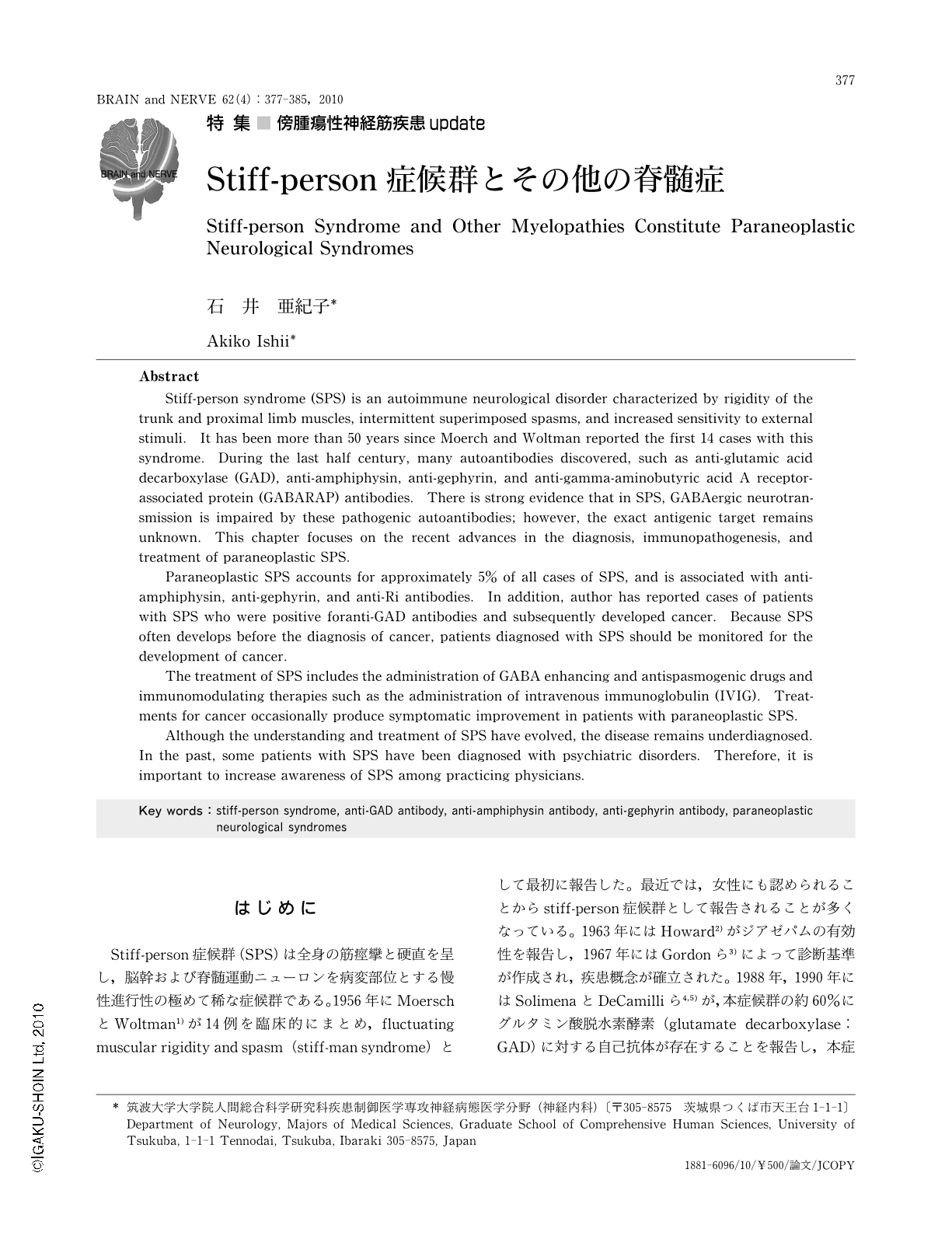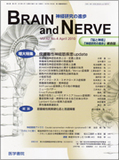Japanese
English
- 有料閲覧
- Abstract 文献概要
- 1ページ目 Look Inside
- 参考文献 Reference
はじめに
Stiff-person症候群(SPS)は全身の筋痙攣と硬直を呈し,脳幹および脊髄運動ニューロンを病変部位とする慢性進行性の極めて稀な症候群である。1956年にMoerschとWoltman1)が14例を臨床的にまとめ,fluctuating muscular rigidity and spasm(stiff-man syndrome)として最初に報告した。最近では,女性にも認められることからstiff-person症候群として報告されることが多くなっている。1963年にはHoward2)がジアゼパムの有効性を報告し,1967年にはGordonら3)によって診断基準が作成され,疾患概念が確立された。1988年,1990年にはSolimenaとDeCamilliら4,5)が,本症候群の約60%にグルタミン酸脱水素酵素(glutamate decarboxylase:GAD)に対する自己抗体が存在することを報告し,本症候群が自己免疫異常により起こる神経疾患である可能性を示した。その後,悪性腫瘍を合併するamphiphysin I抗体陽性例6)や,縦隔腫瘍に伴ったgephyrin抗体陽性例7)の報告があり,本症候群が傍腫瘍性神経症候群としても発症することが明らかになってきた。
SPSの臨床像は多様であり,下肢に比較的症状が限局するstiff-limb症候群8)や,脳幹症状を随伴するprogressive encephalomyelitis with rigidity and myoclonus(PERM)9)なども共通の病態と考えられている。BrownとMarsden10)は,典型的なstiff-man症候群のほかにstiff-man plus症候群という名称を用いて,急速な経過をたどるPERと,比較的慢性の経過をたどるjerking stiff-person症候群,stiff-limb症候群の3タイプに分けている。
以上のように,本症候群の臨床症状は単一ではなく,病因も単一ではない。臨床症状はしばしば日内や日ごとに変動し,転換性障害と誤診されることもある。抗体陰性例も多く,しばしば確定診断が困難な症例も存在する。筋硬直や筋痙攣の症例に遭遇した際には,常にSPSを念頭において診断治療を行うことが大切であると考えられる。本稿では,傍腫瘍性神経症候群の観点からSPSの臨床と病因について概説する。
Abstract
Stiff-person syndrome (SPS) is an autoimmune neurological disorder characterized by rigidity of the trunk and proximal limb muscles, intermittent superimposed spasms, and increased sensitivity to external stimuli. It has been more than 50 years since Moerch and Woltman reported the first 14 cases with this syndrome. During the last half century, many autoantibodies discovered, such as anti-glutamic acid decarboxylase (GAD), anti-amphiphysin, anti-gephyrin, and anti-gamma-aminobutyric acid A receptor-associated protein (GABARAP) antibodies. There is strong evidence that in SPS, GABAergic neurotransmission is impaired by these pathogenic autoantibodies; however, the exact antigenic target remains unknown. This chapter focuses on the recent advances in the diagnosis, immunopathogenesis, and treatment of paraneoplastic SPS.
Paraneoplastic SPS accounts for approximately 5% of all cases of SPS, and is associated with anti-amphiphysin, anti-gephyrin, and anti-Ri antibodies. In addition, author has reported cases of patients with SPS who were positive foranti-GAD antibodies and subsequently developed cancer. Because SPS often develops before the diagnosis of cancer, patients diagnosed with SPS should be monitored for the development of cancer.
The treatment of SPS includes the administration of GABA enhancing and antispasmogenic drugs and immunomodulating therapies such as the administration of intravenous immunoglobulin (IVIG). Treatments for cancer occasionally produce symptomatic improvement in patients with paraneoplastic SPS.
Although the understanding and treatment of SPS have evolved,the disease remains underdiagnosed. In the past,some patients with SPS have been diagnosed with psychiatric disorders. Therefore,it is important to increase awareness of SPS among practicing physicians.

Copyright © 2010, Igaku-Shoin Ltd. All rights reserved.


